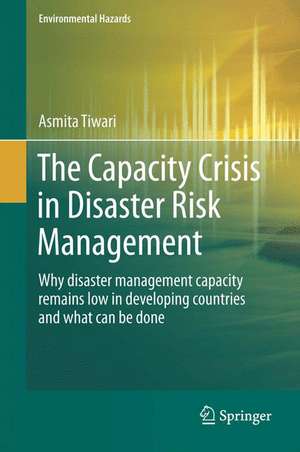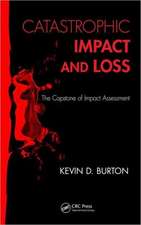The Capacity Crisis in Disaster Risk Management: Why disaster management capacity remains low in developing countries and what can be done: Environmental Hazards
Autor Asmita Tiwarien Limba Engleză Hardback – 25 mar 2015
| Toate formatele și edițiile | Preț | Express |
|---|---|---|
| Paperback (1) | 555.85 lei 38-44 zile | |
| Springer International Publishing – 6 oct 2016 | 555.85 lei 38-44 zile | |
| Hardback (1) | 643.84 lei 6-8 săpt. | |
| Springer International Publishing – 25 mar 2015 | 643.84 lei 6-8 săpt. |
Preț: 643.84 lei
Preț vechi: 757.46 lei
-15% Nou
Puncte Express: 966
Preț estimativ în valută:
123.22€ • 128.16$ • 101.72£
123.22€ • 128.16$ • 101.72£
Carte tipărită la comandă
Livrare economică 14-28 aprilie
Preluare comenzi: 021 569.72.76
Specificații
ISBN-13: 9783319094045
ISBN-10: 3319094041
Pagini: 218
Ilustrații: XVIII, 218 p. 31 illus., 29 illus. in color.
Dimensiuni: 155 x 235 x 17 mm
Greutate: 0.51 kg
Ediția:2015
Editura: Springer International Publishing
Colecția Springer
Seria Environmental Hazards
Locul publicării:Cham, Switzerland
ISBN-10: 3319094041
Pagini: 218
Ilustrații: XVIII, 218 p. 31 illus., 29 illus. in color.
Dimensiuni: 155 x 235 x 17 mm
Greutate: 0.51 kg
Ediția:2015
Editura: Springer International Publishing
Colecția Springer
Seria Environmental Hazards
Locul publicării:Cham, Switzerland
Public țintă
ResearchCuprins
Part I: Capacity Crisis.- Part II: Effective Capacity for Managing Disasters.
Notă biografică
Asmita Tiwari is a development practitioner in the fields of disaster risk management, international development, urban development and environmental management. As a little girl, growing up in Bhopal, India, she was deeply affected by the Union Carbide disaster (Bhopal Gas Tragedy) that took lives of thousands of people in one night. Her passion to understand more about disaster management took her to multiple countries in Africa, the Middle East and South Asia—while working for major international development agencies as a Disaster Risk Management Specialist. Her primary job has been to support governments in the aftermath of disasters, particularly in developing their capacity to reduce future disaster impacts. This book is a culmination of her fifteen years long journey to understand how to better manage disasters and disaster risks. She has a PhD in Public Administration and Policy and Masters in Urban and Regional Planning. She is currently based in Albany, New York.
Textul de pe ultima copertă
How can a place be built and managed so that it is safe for people to live? Ironically, many governments and citizens keep on asking the same question after every new disaster. Why, even with high levels of investment in increasing government’s capacity to manage disasters, do the impacts of disasters continue to increase? What can the governments do differently? What is the role of local communities? Where should aid agencies invest? This book looks into these critical questions and highlights how current capacity development efforts might be resulting in the opposite—capacity crisis or capability trap. The book provides a new approach for understanding and developing effective local capacity for reducing and managing future disaster impacts.
Caracteristici
Brings capacity development and disaster management fields together—which has not been done before Presents a framework to understand capacity development for disaster management Summarizes the current theories and practices as well as presents the results from practical field research, making it appealing to both academicians and practitioners Includes supplementary material: sn.pub/extras



















